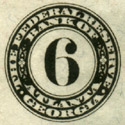
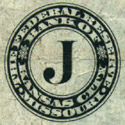


A minor change was made to the FRNs soon after their introduction: Beginning with Series 1928B for the $5, $10, and $20 and Series 1928A for the $50 and $100, the large district number in the Fed seal was replaced by the district letter.
Soon after, an even more minor change affected only the $20 FRN: The face plate number, at the lower right of the note, was moved from its position below the large TWENTY to a new location to the right of it. The move occurred at the beginning of Series 1928C, and appears to have been necessary in order to accommodate the rather tall signature of the new Treasury secretary, Ogden Mills.
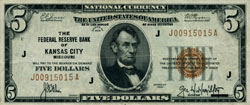
In early 1933, with the Depression at its worst, the Treasury needed to quickly increase the supply of currency in circulation. This posed a problem, since the total value of outstanding SCs and GCs was limited by the Treasury's metals holdings, and likewise the total circulation of USNs, of FRNs, and of Nationals were each subject to legal requirements that did not easily allow for rapid increases. It was for this reason that the Federal Reserve Bank Notes, which had not been issued since the large-size era, were reintroduced; the law governing these notes was such that a large quantity could be issued quickly. The new FRBNs were produced by the BEP in record time, but in achieving such speed, certain corners were cut. These notes were printed from the existing National Currency printing plates--the type designation "Federal Reserve Bank Note" actually appears nowhere on the notes themselves! Changes to the legend and to the bank signers' titles were accomplished by an overprint, blacking out the inapplicable wording and adding the new, often poorly aligned and overlapping other elements of the design. The FRBNs' serials and seals were printed in the same brown ink used on the Nationals; however, the seal used was not the small one appearing on the Nationals, but the larger one common to all other currency types. The legend at the top of each note reads "Secured by United States bonds deposited with the Treasurer of the United States of America or by like deposit of other securities"; all other legal wording is unchanged from the National Currency plates.
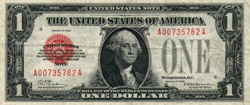
The $1 USN was introduced at around the same time as the FRBNs, and for somewhat similar reasons. Originally intended to serve as a supplement to the $1 SC which was then the only type of $1 note in circulation, it was found to be both unnecessary and impractical for the purpose: No shortage of $1 notes materialised, and if it had done, the law capping the total dollar value of USNs in circulation would not have allowed the $1 USNs to be issued quickly enough to alleviate it. Realising this, the Treasury called off the printing of $1 USNs less than a month after it had begun, and halted the issue of these notes after only a few thousand had entered circulation. (The remainder of the small printing remained in Treasury vaults until 1949, when it was decided that to issue the notes would be more efficient than to store them indefinitely. They were then released, over a period of several months, in Puerto Rico, in the hope that relatively few of them would find their way back to the mainland where their red seals might cause them to be mistaken for higher-denomination notes.) Except for the legal wording, which conformed to the other USNs, the $1 USN was identical in design to the contemporary $1 SC--though it did have the odd feature of carrying its type designation in two places, both above the portrait and around the legend and seal.
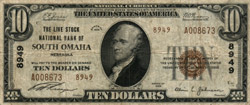
The Nationals also underwent a small design change in 1933: Beginning in May of that year, each note had the issuing bank's charter number printed four times instead of two. At the same time, the suffix letter was dropped from the serial numbers on these notes, and the pattern of serials on each sheet was changed. This last adjustment brought the serialling of the Nationals more into line with that of all other types, which seems to have been the BEP's main reason for the changes. (See here for more details on the serial numbering of the Nationals vs. that of other currency.)
Also in 1933, the first small-size $10 SCs were introduced. These notes were designated Series 1933, and had the same design style as the $1 SCs of Series 1928. However, the text of these notes was substantially different; they carried the shortened obligation "Ten dollars payable in silver coin to the bearer on demand", and the legend "This certificate is issued pursuant to Section 45 of the Act of May 12, 1933, and is legal tender at its face value for all debts public and private." Also, these $10 SCs differed from the small-size $10 FRNs and GCs in that the lathework along their side borders was of a different design. Previously, notes of different types but the same denomination had not differed in this regard, but over the next few years, each type would receive its own distinct lathework.


At about the same time, the legend on the $1 SC was simplified. Beginning with the notes of Series 1928E, it reads simply "This certificate is legal tender for all debts, public and private".
Next: The redesign of
1934